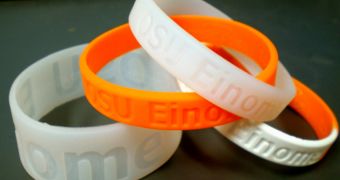According to a new paper published in a recent issue of the journal Environmental Science & Technology, determining what pollutants and other harmful chemical compounds people living in a given region are exposed to on a daily basis might be as simple as asking them to wear a wristband.
Oddly enough, the wristbands that people would have to wear to help scientists better understand the distribution of potentially harmful chemical compounds would not even have to be fancy ones. On the contrary, regular silicone ones would do.
In their paper, scientist Kim Anderson and his fellow researchers explain that, while going about their daily routine, people are exposed to lots of substances that they either breathe in or that come in contact with their skin.
On many occasions, it actually happens that these substances are ingested, the specialists go on to explain in the American Chemical Society's journal.
The trouble is that, in order to determine which of these compounds constitute a threat to public health in the context of long-term exposure, even if in very small amounts, measurements must be carried out over lengthy periods of time.
Up until now, such measurements have boiled down to asking people to fill in various questionnaires, or relying on heavy backpack samplers or stationary devices.
According to Kim Anderson and his colleagues, these methods of keeping tabs on exposure to various toxins are not all that reliable, simply because they more often than not fail to record the presence of some compounds.
The researcher say that, as shown by their investigations into the matter at hand, silicone wristbands that are already commercially available can prove a more trustworthy alternative.
This is because silicone tends to suck in a wide range of compounds, and can therefore offer information concerning the substances that the wearer of a wristband made from this material was exposed to while engaged in various activities.
After asking several volunteers to wear such wristbands for a while and then bringing them back to their laboratory, the researchers were able to pin down traces of as many as 49 different compounds in the silicone.
Of these compounds, some were polycyclic aromatic hydrocarbons, some of which have previously been linked to increased cancer risk, and others came from pesticides and consumer products.
“We can screen for over 1,000 chemicals that may accumulate in the wristbands,” researcher Kim Anderson explains. “Currently, PAHs, pesticides, flame retardants, PCBs, industrial chemicals and consumer and pharmaceutical products have been quantified in wristbands,” he adds.
Based on the findings of this investigation, the specialists argue that silicone wristbands can prove a useful tool when it comes to determining what compounds an individual is exposed to on a regular basis. They might even help establish which of these substances are harmful and which are not, the scientists argue.

 14 DAY TRIAL //
14 DAY TRIAL //